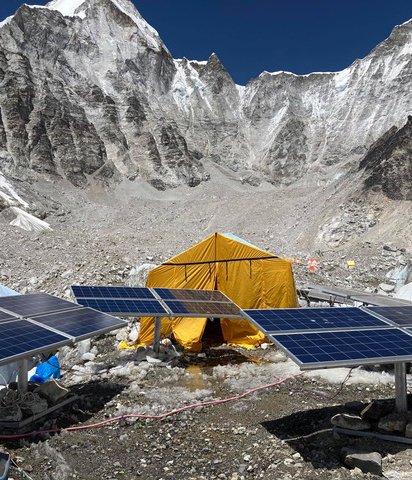About Solar
Sunlight is energy. When light hits a surface, most of it turns into heat (imagine sitting out in the sun). But, when light hits certain surfaces, a portion of it is converted to electrical energy. Solar photovoltaic panels generate this electric energy when exposed to photons from sunlight. These photons push electrons through silicon wafer cells resulting in an electrical current at a predictable voltage. As the strength of the day’s sunlight intensifies, so does the current output from the solar panels.
Learn more about how solar works below or see if the answer you're looking for is under our FAQs.

How Solar works
Solar panels create what is called DC (Direct Current) electricity by capturing energy from sunlight. Home appliances use AC (Alternating Current) electricity though, which means an inverter must be used to transform the DC into AC before it can be used in our homes.
The difference between DC and AC is in the way the electricity flows. DC electricity travels on a one way path flowing around a circuit. Think of a battery powering a fan, where electrons start at the negative side of the battery, flow to the fan, then return to the positive side of the battery. With AC electricity, however, electrons are pushed and pulled back and forth, rapidly reversing direction. This form of free-flowing electricity allows us to power a variety of appliances with varying voltage needs and allows overproduced or unused solar energy to feed onto the grid.
A little piece of history for you here: AC electricity was chosen for the US’s power grid mostly because it was the cheapest method to transmit over long distances.
Benefits of Solar
01
Renewable Energy Source
Solar energy is a truly renewable energy source. It can be harnessed in all areas of the world and is available every day. We will never run out of solar energy, unlike conventional sources of energy, and it will be accessible as long as we have the sun - another 5 billion years. So, we think we’re good for now.
02
Can Reduce Electricity Bills
Since you will be substituting some of your energy needs with the electricity generated by your solar power system, your energy bills will drop. How much you save on your bill will be dependent on the size of the solar system, your electricity usage, and the utility rate you pay per kilowatt-hour. These savings come in two forms; the energy you did not need to buy because your solar powered your loads directly during daylight hours, and the value of excess generation during times where your system may have been producing more power than was being used at times during the day.
03
Diverse Applications
Solar energy can be used for a variety of purposes. You can generate electricity (photovoltaics) or heat (solar thermal). Solar energy can be used to produce electricity in areas without access to the energy grid, to distill water in regions with limited clean water supplies, and to power satellites in space. Solar energy can also be integrated into the materials used for buildings. Not long ago Sharp introduced transparent solar energy windows. What will be next?!
04
Low Maintenance Costs
Solar energy systems don’t require a lot of maintenance but they do need some. Soiling can impact productivity, so some owners clean their array a couple of times per year if it is in a safe and convenient location. Monitoring the system will help to catch any problems early so they can be addressed quickly. Most reliable solar panel manufacturers offer a 20-25 year warranty. Most grid-connected solar power systems go years between service visits. So, after covering the initial cost of the solar system, you can expect limited spending on maintenance and repair work.
05
Evolving Technology
Technology in the solar industry is constantly advancing and improvements will intensify in the future. With each passing year, solar panel efficiency improves a bit while the power conversion electronics become more reliable and lower cost. Innovations in quantum physics and nanotechnology may even increase the effectiveness of solar panels.
06
Environmentally Friendly
Climate change, as caused by the emission of greenhouse gasses by humans in the last several generations, is the greatest challenge our world faces today. Solar is one of the best tools available to us to reduce, and eventually eliminate, the production of greenhouse gases in our electric energy generation. We can't afford to waste a moment in the wholesale conversion of our nation’s energy generating infrastructure.
Fun Fact
From Alaska to Antarctica, Mexico to Mount Everest, Creative Energies has installed solar all over the world!


